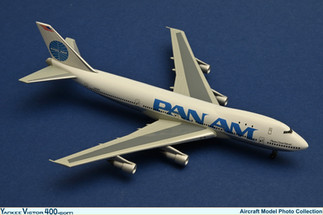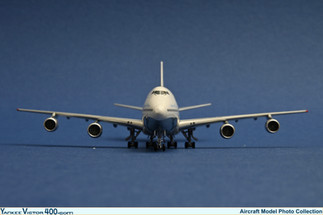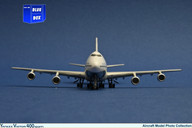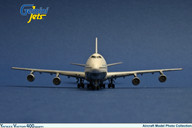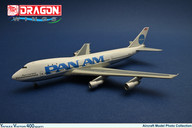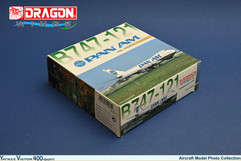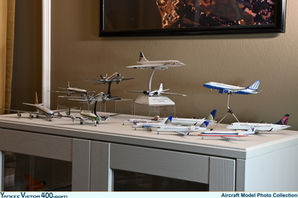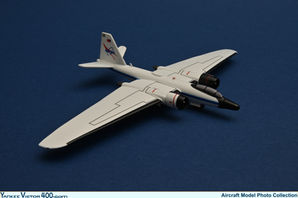The History of the 1:400 747-100 in 5 Models
- Jorge A. Zajia
- Sep 28, 2025
- 12 min read
Updated: Oct 11, 2025
In October 2022, I wrote an article titled "A Poor Man's Classic 747 Collection in 1:400 Scale." The article was about how hard it was to find Aeroclassics 747s in 1:400 scale, and how, in many cases, I had to settle for examples of lesser prestige.
Among the models featured in that article was a Pan Am 747-100 in the Billboard livery by the original Blue Box, N747PA Clipper Juan T. Trippe. For well over a decade, that model was the only Pan Am 747 in the Billboard livery in my collection. As it turns out, that model, along with many others released on the same mold, is also one of the worst Pan Am 747s in 1:400 scale. But beggars can't be choosers, and for well over a decade, I was glad to have it in my collection.
Things improved a bit in May 2024 when I found a Dragon Wings example for a decent price on eBay.
Little did I know that just over a year later, in July 2025, I was going to have in front of me two dozens of fresh-from-the-oven Pan Am 747s in a brand new, state of the art, 747-100 mold by a new brand called HX Model. Of course, such volume was for retail purposes, but one of them found its way into my collection.
Then, only a few months later, in August 2025, Waffle Collectibles rolled out the "largest 1:400 collection sale EVER!!!," which enabled me to add to my collection two more Pan Am 747s in the Billboard livery. A GeminiJets that I missed out on in 2015 during a collecting hiatus, and an Aeroclassics that had been released in February of 2008, only eleven months before buying my first 1:400 scale airplane model, coincidentally, from Waffle Collectibles as well (They were called Air Paradigm at the time).
After having gotten my hands on the HX example, I didn't really need the two from the Waffle sale from a level-of-accuracy standpoint. However, I needed them for historical purposes.
I encourage you to go ahead and get comfy, and maybe have a bookmark ready, because with these five Pan Am 747s, we are going to cover a lot of ground on the hobby of collecting 1:400 scale airplane models.
To see a comprehensive set of comparison photos, scroll to the bottom of the publication.
About Pan Am and the 747
Pan American World Airways is probably the most influential airline in current history, as it propelled the air travel industry into what it is today. Pan Am was instrumental in the materialization of the Boeing 747, the first jumbo jet in history, and became the largest operator of the original variant of the type, the 747-100. The airline also operated a good number of the shorter 747-SP.

Pan Am went out of business in 1991, but its legacy is far from forgotten, and collectors from every corner of the world, young and old, cherish the airline, which is why Pan Am 747s are so popular. To date, there have been a total of 63 Pan Am 747s mass-produced in 1:400 scale. In case you are wondering, there are several airlines whose liveries have adorned far more 1:400 747s (JAL could be at the top with 120+ models), but it is still not bad for an airline that only operated one major variant of the type, and that went out of business several years before 1:400 airplane models became a thing.
At least 20 of those 63 models wear the Billboard livery, the last livery of the airline. Every major player in the hobby, except Phoenix (I don't think many people will be upset by it), has made its own contribution to this list, as well as one obscure brand called Radscale Models (the only mold that will not be featured in this article). Aeroclassics even launched a dedicated sub-brand to weather potential licensing hurdles: The Pan Am Model Company (PAMC).
The Models
I will present the models in the order they were released, and not in the order in which I acquired them, as it offers an excellent opportunity to go over the evolution of 1:400 scale.
Model 1, Dragon Wings: Boeing 747-121 N737PA "Clipper Ocean Herald"

Released in 1999, this is the first Pan Am 747 produced in 1:400 scale wearing the Billboard livery. 1999 was also the first year that Pan Am 747s were released in 1:400 scale in any livery, with GeminiJets releasing another two (a -100 and an SP, both in the cheatline livery). Dragon Wings themselves are thought to be behind the first 1:400 airplane models ever mass-produced, only three years prior, in 1996, according to Yesterday's Airlines.
For its time, Dragon Wings produced outstanding models. To this day, the shape of their 747-100 fuselage is considered to be a near-perfect replica of the real thing. Their models came with removable landing gears and a nice display stand.
Some of their drawbacks include unrefined details on areas such as engine pylons and landing gear struts, a lack of printed details, and, for some people, the plastic wings and tail. It is worth noting that not all of DW's molds were as stunning as their 747s.
Dragon Wings was based in Hong Kong, but conducted businesses in the same way that the other major airplane model brands of the time did, all of which were based in Western countries (Herpa in Germany, and GeminiJets in the U.S.). Dragon models were licensed, their packaging portrayed a standardized artwork format, and they had a solid distribution network outside of Asia. They offered a good product with a large consumer base in mind, instead of the niche of connoisseur collectors, who at the time focused on 1:200 scale.
The model in question is well-executed. The one glaring inaccuracy that jumps out at me is the name of the aircraft, which is black instead of blue. The cockpit windows are a tad low and a tad small, also, but at least they are not oversized.
Model 2, Blue Box: Boeing 747-121 N747PA "Clipper Juan T. Trippe"

This model was released in 2005 in a different landscape than that of the late 1990s. By now, several players had entered the scene. Relevant to the discussion of this model is one particular brand: Aeroclassics.
Remember how I mentioned that in the late 1990s, most mass-produced scale airplane models were licensed (DW, GJ, and Herpa) and appealed to the general consumer instead of connoisseurs, who mainly collected 1:200 models at the time?
Well, that 1:200 connoisseur collecting community was concentrated in Europe, mainly in England, and the issue of licensing was just not part of it. We are talking about a rather underground network of hobbyists whose production lines were closer to artisan shops than to the industrial assembly lines of the Far East, and whose clientele was equally niche. One of these UK modellers decided to make smaller models in 1:400 scale (maybe inspired by the 1:500 and 1:600 models that were coming out of Germany at the time?). They became known as Aeroclassics, and their residency in the UK was short-lived as they moved to China in 2000, about two years after their inception. As mentioned earlier, the close-knit community of UK modelers was largely oblivious to the issue of licensing. And that did not change when Aeroclassics moved its production to China. And so began one of the great dilemmas of the hobby: licensed vs. non-licensed, legal vs. illegal, fake vs. genuine.
With the arrival of new brands and the introduction of the unlicensed mass-produced airplane model, the hobby started to proliferate, and some local actors started to try their hand at making models on their own, without a Westerner or Hongkonger at the top. One early brand from Mainland China was Blue Box.
Blue Box became known for its L-1011s, while its "sister" brand, Magic Model, became known for its 747s. Nonetheless, several 747s using the "Magic" mold were released under the Blue Box banner as well.
The reason I decided to use this section to explain how Aeroclassics came to be is that I believe they were a huge influence/inspiration for Blue Box.
By 2005, Aeroclassics and Big Bird, their newfound friend from Hong Kong, had been putting out a series of highly praised 747s using a line of innovative molds that earned them a solid place in the market, much to the dismay of the well-established brands.
While Blue Box and Magic went on to find their niche markets before failing, many of their 747 releases were clearly a copy of - or heavily inspired by, you could say - what Aeroclassics was doing at the time. Such is the case of the model presented here.
The Blue Box/Magic 747-100 does seem like a poor copy of the Big Bird/Aeroclassics mold, with some improvements, nonetheless.
Without dissecting the model, I would say the tail of the Blue Box mold was better than the Aeroclassics one, but the nose section and the wing box were worse. Everything else was comparable. Some collectors have said that the Blue Box/Magic 747-100 mold is the worst in the scale, but I actually share Yesterday's Airlines' opinion on this one: overall, it is not a bad mold for its time.
Blue Box/Magic 747s were notorious for poor paint application, which resulted in many severe cases of paint bubbling (sometimes mistaken for zinc rot). My Pan Am example only suffers mildly from this condition, and it is limited to the wing fuel tank coroguard.
On the brighter side, these models show us the first inclination of Chinese brands to focus on innovation and luxury packaging. Blue Box boxes were particularly sturdy and incorporated a liftable flap, which was an exclusive feature of GeminiJets boxes at the time. Additionally, Blue Box/Magic 747s featured a series of bumps on top of the fuselage, which represent one of the first attempts at introducing antennas in 1:400 models. Primitive rolling gears are also present (either that, or the tires have become loose with time). As we now know, today's brands from Mainland China (NG, Panda, HX) are on a tier of their own when it comes to mold accuracy and level of detail, and attention to packaging continues to be a common theme among them. Brands such as Patriot Model largely base their business model around luxury packaging. We also have NG's "Ultimate" collection, and even regular boxes of Chinese brands feature very tasteful artwork.
As far as the model itself, I can easily see two issues. First, the placement of the cockpit windows is clearly too low. Looks very awkward. The other issue is that I believe N747PA never wore the Billboard livery without also featuring the Side Cargo Door (SCD) on the port side, which is not present on the model.
Model 3, Aeroclassics (PAMC): Boeing 747-121 N744PA "Clipper Ocean Spray" with Yellow Ribbon

For many years, the mold in which this model is cast was considered to be the best in its class, and to this day, Aeroclassics and Big Bird (Your Craftsman 400) branded 747s, especially from the 2000s, are very sought after. As a matter of fact, out of all the models featured in this article, this is the one that I have paid the most for, and not by a small margin.
The mold first appeared in 2003, and from the start, it was used by both Big Bird and Aeroclassics. The mold is still active under the control of JC Wings, which has enabled its use under different brands in recent times, including their own, and remains largely unaltered (perhaps the longest in-use mold in 1:400 scale?). In fact, recent Aeroclassics 747s are effectively identical to those from the 2000s, mold-wise, as they don't feature antennas, and artwork remains basic. However, older Aeroclassics, such as the model presented here, are considered superior, as recent ones exhibit a series of shortcomings in terms of artwork application, mold polishing, etc.
The mold was revolutionary for its time because it offered several advantages over the competition (Dragon Wings, GJ 1st gen., and Herpa). It was all metal, only had one seam (wing box), its overall shape was very eye-pleasing, and its landing gear was very detailed.
In 2005, both Big Bird and Aeroclassics (under the PAMC banner) started to produce a series of Pan Am 747-100s. Soon after, Blue Box followed suit and started to almost duplicate every release using their inferior mold (including Model 2 above).
By 2006, Blue Box had given up copying Aeroclassic and Big Bird's Pan Am 747s. The last release was a titleless version of N747PA released under the Magic brand name (Magic became known for producing those obscure livery variations).
However, Aeroclassics was not done yet, and in February 2008, the PAMC released one last quartet of 747-100s, which included the model presented here. After that quartet, Pan Am 747-100 releases in 1:400 scale have been very punctual.
In 2013, two were released, still using the Big Bird mold. However, at the time, the mold was owned by Witty Wings, and the models were released under the Apollo banner. Then in 2015 (Mar. & Dec.) GeminiJets released another two using a considerably improved version of their 741 mold (we will see one of these releases next). And in February 2024, the PAMC 747 made a reappearance with one release using the Big Bird mold. JC Wings itself has since announced yet another Pan Am 747-100, but as of the writing of this article, it has not seen the light of day. It is assumed that it will also be cast using the Big Bird mold, but in its slightly updated variant known as Big Bird Mk.3 (it's got antennas, and models released on it wear modern printed details). Then, of course, we have the recent HX series, which we also cover later in this article. Oh yes, and there was also that Radscale release in 2024.
Regarding the model in question, for its time, it is absolutely superb, very sharp, and very eye-pleasing. The color blue seems a tad oversaturated, but I like it that way. Aercolassics at its best. I could not find any photos of the real aircraft showing the yellow ribbon on the port side, but anyone who has spent some time trying to verify the accuracy of livery reproduction on scale models should know that it doesn't mean much.
Model 4, GeminiJets: Boeing 747-121 N741PA "Clipper Sparking Wave"

GeminiJets made us wait a long time for their iteration of this iconic aircraft, which was released in December 2015. This is the fourth Pan Am 747-100 produced by GeminiJets, the only one in the Billboard livery, and probably the last one we will see as Gemini has a strict policy of keeping re-releases to a minimum, unless an airline requests it (a difficult thing to do when the airline no longer exists).
I don't know if it was a coincidence or planned, but Gemini waited until all the dust had settled between Aeroclassics and Blue Box to release their first Pan Am 747-100s in well over a decade. By the time of this release, Gemini's 747 mold had been considerably improved, which makes this a rather nice model with modern printed details, well-proportioned antennas, and detailed rolling gears. I wish GeminiJets used this mold more often.
Model 5, HX Model: Boeing 747-121(SCD) N747PA "Clipper Juan T. Trippe"

The first Pan Am 747-100s in 1:400 scale made by a brand from Mainland China appeared 20 years ago, and were not much more than a subpart copy of Aeroclassics and Big Bird (Model 2 in this article). But a lot has happened in those 20 years, and now there is no shortage of innovative brands from Mainland China that have taken 1:400 scale to a whole new level.
While the current generation of standalone Chinese brands started to appear in the mid to late 2010s (Panda in 2015 and NG in 2017), according to Yesterday's Airlines, and seemingly had no meaningful connection to any of the traditional brands, HX's history is different. The brand itself is new (2024, I believe). However, its roots seem to go well before Panda and NG were created, as the brand appears to have links to JC Wings. Details are unclear (and largely irrelevant for this discussion), but it appears that HX was born out of a dispute that took place within JC Wings recently.
HX is the only 1:400 brand that has an active 747-100 mold with slot-in wings, besides Phoenix. However, the latter has so many deficiencies that even current cradle molds such as GJ and Big Bird are considered superior.
The curves of the 747 fuselage, especially around the forward section, are very difficult to replicate accurately, but HX has done a good job in this area, no worse than any other competitive molds in the scale. This, combined with highly accurate slot-in wings, refined details such as pylons and landing gears, and top-notch paint application and pad printing, has created an exceptionally well-received product.
This model is part of a series that HX released in June of 2025, which included five Pan Am 747-100s, four in the Cheatline livery, and one in the Billboard livery. They all came in a nicely executed flaps-down version as well.
Unlike Blue Box's effort (Model 2), HX's version does have the side cargo door.
Conclussion
While these five models have allowed us to cover a lot of ground on the evolution of 1:400 scale, there are many areas that we did not get to touch on. For that, I would like to refer you to www.yesterdaysairlines.com, a site that I have also used extensively in researching for this article.
Some of you are probably wondering which of these five models is the best. Well, I think that's a very subjective question, so that's for you to decide. But as usual, I have an opinion.
The Blue Box one (Model 2) is indeed the worst. The cockpit windows alone are a deal breaker. The Dragon Wings one (Model 1) is not bad, but by now it is just too primitive to be competitive.
The remaining three are all valid options with pros and cons. While I would choose the HX example if I had to keep only one, I think the other two (AC and GJ) are also highly regarded models with their own strengths.
It is worth noting that it isn't only about how innovative a model is, but in some cases, it is about the collectible value that time and other unique factors confer to a model.
Comparative Galleries
The following is a set of photo galleries designed to facilitate comparing the models.



